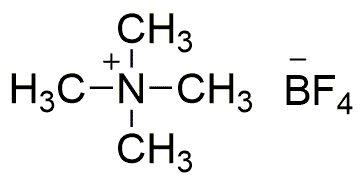Tetramethylammonium tetrafluoroborate is widely utilized in research focused on:
- Electrolytes in Batteries: This compound serves as a highly conductive electrolyte in lithium-ion batteries, enhancing their efficiency and lifespan.
- Organic Synthesis: It acts as a phase-transfer catalyst, facilitating the transfer of reactants between different phases, which is crucial in organic synthesis processes.
- Ion Exchange Applications: The compound is used in ion exchange chromatography, aiding in the separation and purification of various chemical substances.
- Electrochemical Sensors: Its properties make it suitable for developing electrochemical sensors, which are essential in environmental monitoring and quality control in industries.
- Nanotechnology: It plays a role in the synthesis of nanomaterials, contributing to advancements in electronics and materials science.
General Information
Properties
Safety and Regulations
Applications
Tetramethylammonium tetrafluoroborate is widely utilized in research focused on:
- Electrolytes in Batteries: This compound serves as a highly conductive electrolyte in lithium-ion batteries, enhancing their efficiency and lifespan.
- Organic Synthesis: It acts as a phase-transfer catalyst, facilitating the transfer of reactants between different phases, which is crucial in organic synthesis processes.
- Ion Exchange Applications: The compound is used in ion exchange chromatography, aiding in the separation and purification of various chemical substances.
- Electrochemical Sensors: Its properties make it suitable for developing electrochemical sensors, which are essential in environmental monitoring and quality control in industries.
- Nanotechnology: It plays a role in the synthesis of nanomaterials, contributing to advancements in electronics and materials science.
Documents
Safety Data Sheets (SDS)
The SDS provides comprehensive safety information on handling, storage, and disposal of the product.
Product Specification (PS)
The PS provides a comprehensive breakdown of the product’s properties, including chemical composition, physical state, purity, and storage requirements. It also details acceptable quality ranges and the product's intended applications.
Certificates of Analysis (COA)
Search for Certificates of Analysis (COA) by entering the products Lot Number. Lot and Batch Numbers can be found on a product’s label following the words ‘Lot’ or ‘Batch’.
Numéro de catalogue
Numéro de lot/série
Certificates Of Origin (COO)
This COO confirms the country where the product was manufactured, and also details the materials and components used in it and whether it is derived from natural, synthetic, or other specific sources. This certificate may be required for customs, trade, and regulatory compliance.
Numéro de catalogue
Numéro de lot/série
Safety Data Sheets (SDS)
The SDS provides comprehensive safety information on handling, storage, and disposal of the product.
DownloadProduct Specification (PS)
The PS provides a comprehensive breakdown of the product’s properties, including chemical composition, physical state, purity, and storage requirements. It also details acceptable quality ranges and the product's intended applications.
DownloadCertificates of Analysis (COA)
Search for Certificates of Analysis (COA) by entering the products Lot Number. Lot and Batch Numbers can be found on a product’s label following the words ‘Lot’ or ‘Batch’.
Numéro de catalogue
Numéro de lot/série
Certificates Of Origin (COO)
This COO confirms the country where the product was manufactured, and also details the materials and components used in it and whether it is derived from natural, synthetic, or other specific sources. This certificate may be required for customs, trade, and regulatory compliance.


